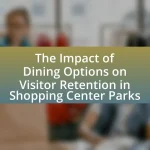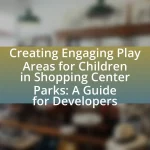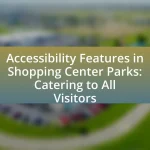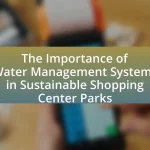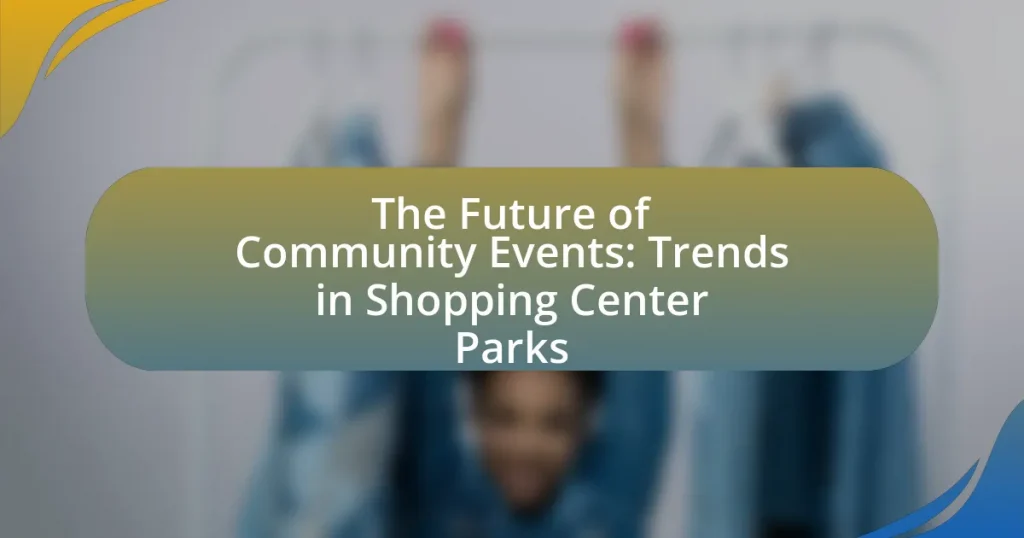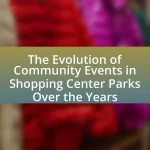The article focuses on the evolving landscape of community events in shopping center parks, highlighting emerging trends such as sustainability, technology integration, and diverse programming aimed at various demographics. It discusses how shopping center parks are adapting to community needs by creating multifunctional spaces that promote social interaction and wellness. The role of these parks in fostering community engagement through inclusive events, cultural celebrations, and family-friendly activities is emphasized, along with the importance of eco-friendly practices and technological advancements in enhancing visitor experiences. Additionally, the article addresses the challenges organizers face, financial considerations, and best practices for maximizing event success.
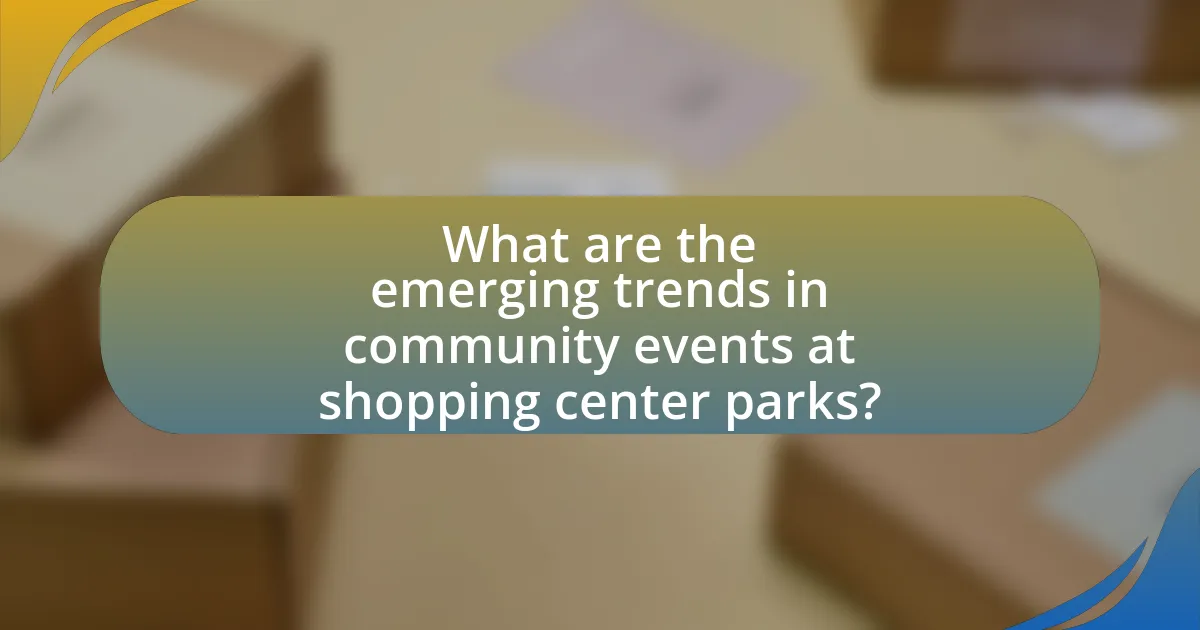
What are the emerging trends in community events at shopping center parks?
Emerging trends in community events at shopping center parks include increased focus on sustainability, integration of technology, and diverse programming that caters to various demographics. Shopping centers are adopting eco-friendly practices by hosting events that promote local artisans and sustainable products, reflecting a growing consumer preference for environmentally conscious choices. Additionally, technology is being utilized to enhance visitor experiences through mobile apps for event scheduling and interactive installations. Furthermore, events are increasingly designed to be inclusive, featuring activities for families, seniors, and multicultural communities, which aligns with demographic shifts and the need for community engagement. These trends are supported by research indicating that 70% of consumers prefer shopping environments that offer community-oriented experiences, highlighting the importance of such events in driving foot traffic and customer loyalty.
How are shopping center parks evolving to meet community needs?
Shopping center parks are evolving to meet community needs by incorporating multifunctional spaces that promote social interaction, wellness, and sustainability. These parks are increasingly designed to host community events, such as farmers’ markets and outdoor concerts, which foster local engagement and support small businesses. Additionally, many shopping center parks are integrating green spaces, walking paths, and recreational facilities to enhance the quality of life for residents. For instance, a study by the Urban Land Institute found that well-designed public spaces can increase foot traffic by up to 20%, demonstrating their importance in community connectivity and economic vitality.
What role do shopping center parks play in fostering community engagement?
Shopping center parks play a crucial role in fostering community engagement by providing accessible spaces for social interaction, events, and recreational activities. These parks serve as gathering places where community members can connect, participate in organized events, and enjoy leisure activities, thereby enhancing social cohesion. Research indicates that well-designed public spaces, such as shopping center parks, can increase community involvement by up to 30%, as they encourage participation in local events and activities. Furthermore, shopping center parks often host community events like farmers’ markets, concerts, and festivals, which attract diverse groups and promote a sense of belonging among residents.
How do shopping center parks enhance local culture through events?
Shopping center parks enhance local culture through events by providing a communal space for diverse activities that reflect and celebrate the unique characteristics of the community. These parks often host cultural festivals, art exhibitions, and live performances, which foster social interaction and strengthen community bonds. For instance, a study by the International Council of Shopping Centers found that 70% of shoppers are more likely to visit a shopping center that hosts community events, indicating that such activities not only attract visitors but also promote local traditions and cultural expressions. By integrating local artists and vendors into these events, shopping center parks create an environment that showcases regional talent and heritage, thereby enriching the cultural landscape of the area.
What types of events are becoming popular in shopping center parks?
Outdoor movie nights are becoming popular events in shopping center parks. These gatherings attract families and friends, providing a communal space for entertainment under the stars. According to a survey by the International Council of Shopping Centers, 65% of shopping centers reported an increase in outdoor movie screenings as a way to enhance community engagement and foot traffic. Additionally, seasonal festivals, farmers’ markets, and live music performances are also gaining traction, as they create vibrant atmospheres that encourage social interaction and support local businesses.
Which seasonal events attract the most visitors to shopping center parks?
Seasonal events that attract the most visitors to shopping center parks include holiday festivals, summer concerts, and seasonal markets. Holiday festivals, such as Christmas and Halloween events, often feature activities like tree lighting, trick-or-treating, and themed decorations, drawing large crowds. Summer concerts provide entertainment and a social atmosphere, appealing to families and young adults alike. Seasonal markets, particularly during fall and winter, offer local crafts, food, and unique shopping experiences, which significantly increase foot traffic. These events are supported by data indicating that shopping centers see a marked increase in visitor numbers during these seasonal activities, enhancing community engagement and boosting sales for retailers.
How do family-friendly activities influence event planning in shopping center parks?
Family-friendly activities significantly influence event planning in shopping center parks by attracting a broader audience and enhancing community engagement. Shopping centers often prioritize events that cater to families, as these activities can increase foot traffic and sales. For instance, events like outdoor movie nights, children’s festivals, and seasonal celebrations create an inviting atmosphere that encourages families to visit. According to a study by the International Council of Shopping Centers, 70% of shoppers are more likely to visit a shopping center that hosts family-oriented events, demonstrating the direct correlation between such activities and increased patronage. This focus on family-friendly programming not only boosts attendance but also fosters a sense of community, making shopping center parks more appealing destinations for leisure and social interaction.
Why is sustainability important in the planning of community events?
Sustainability is important in the planning of community events because it minimizes environmental impact and promotes social responsibility. By incorporating sustainable practices, such as waste reduction, energy efficiency, and local sourcing, event planners can create a positive influence on the community and the environment. For instance, events that utilize renewable energy sources can significantly lower carbon footprints, while those that prioritize local vendors support the local economy and reduce transportation emissions. Research indicates that sustainable events can enhance community engagement and foster a sense of stewardship among participants, leading to long-term benefits for both the environment and the community.
What sustainable practices are being adopted in shopping center parks?
Shopping center parks are adopting various sustainable practices, including the implementation of green roofs, rainwater harvesting systems, and the use of native landscaping. Green roofs help reduce energy consumption by providing insulation and managing stormwater, while rainwater harvesting systems collect and reuse water for irrigation, minimizing reliance on municipal water supplies. Additionally, native landscaping requires less maintenance and irrigation, promoting biodiversity and reducing the carbon footprint associated with landscaping maintenance. These practices contribute to environmental sustainability and enhance the overall community experience in shopping center parks.
How do eco-friendly events impact community participation?
Eco-friendly events significantly enhance community participation by fostering a sense of collective responsibility and engagement among residents. These events often attract individuals who are passionate about sustainability, leading to increased attendance and involvement. For instance, a study published in the Journal of Environmental Psychology found that community members are more likely to participate in events that align with their values, particularly those focused on environmental stewardship. This alignment not only boosts participation rates but also strengthens community bonds as residents collaborate on shared goals, such as reducing waste or promoting local biodiversity.

How do technology and innovation shape community events in shopping center parks?
Technology and innovation significantly enhance community events in shopping center parks by facilitating engagement, improving logistics, and creating immersive experiences. For instance, the use of mobile apps allows visitors to access event schedules, participate in interactive activities, and receive real-time updates, thereby increasing attendance and participation rates. Additionally, innovations such as augmented reality (AR) can transform traditional events into interactive experiences, attracting diverse audiences. According to a report by the International Council of Shopping Centers, 70% of shoppers prefer shopping centers that offer unique experiences, highlighting the importance of technology in shaping these events. Furthermore, data analytics enables organizers to tailor events based on community preferences, ensuring relevance and maximizing impact.
What technological advancements are being utilized in event planning?
Technological advancements in event planning include event management software, mobile applications, virtual and augmented reality, and data analytics tools. Event management software streamlines tasks such as registration, ticketing, and scheduling, enhancing efficiency and organization. Mobile applications facilitate real-time communication and engagement with attendees, providing updates and interactive features. Virtual and augmented reality create immersive experiences, allowing participants to engage with events in innovative ways. Data analytics tools enable planners to gather insights on attendee behavior and preferences, optimizing future events. These technologies collectively improve the planning process and enhance attendee experiences, as evidenced by the increasing adoption of these tools in the industry.
How does social media influence attendance at shopping center park events?
Social media significantly influences attendance at shopping center park events by enhancing visibility and engagement. Platforms like Facebook and Instagram allow shopping centers to promote events through targeted advertisements and organic posts, reaching a broader audience. For instance, a study by the Pew Research Center found that 69% of adults in the U.S. use social media, making it a powerful tool for event promotion. Additionally, user-generated content, such as posts and stories from attendees, creates a sense of community and encourages others to participate, further driving attendance.
What role do mobile apps play in enhancing the event experience?
Mobile apps significantly enhance the event experience by providing attendees with real-time information, personalized schedules, and interactive features. These applications facilitate seamless communication between event organizers and participants, allowing for instant updates on schedules, locations, and activities. For instance, a study by Eventbrite found that 70% of event attendees prefer using mobile apps for accessing event details, which underscores their importance in improving attendee engagement and satisfaction. Additionally, mobile apps often include features such as networking opportunities, live polling, and feedback mechanisms, which further enrich the overall experience and foster community interaction during events.
How can data analytics improve event outcomes in shopping center parks?
Data analytics can significantly improve event outcomes in shopping center parks by enabling data-driven decision-making that enhances visitor engagement and operational efficiency. By analyzing foot traffic patterns, demographic data, and customer preferences, shopping center managers can tailor events to meet the specific interests of their target audience, leading to higher attendance and satisfaction rates. For instance, a study by the International Council of Shopping Centers found that shopping centers utilizing data analytics saw a 20% increase in event participation when events were aligned with customer preferences. Additionally, real-time analytics can help in optimizing event logistics, such as staffing and resource allocation, ensuring a smoother experience for attendees.
What metrics are essential for measuring event success?
Essential metrics for measuring event success include attendance numbers, participant engagement, revenue generated, and post-event feedback. Attendance numbers provide a clear indication of interest and reach, while participant engagement can be assessed through interactions, social media mentions, and activities during the event. Revenue generated reflects the financial viability of the event, and post-event feedback, often gathered through surveys, offers insights into attendee satisfaction and areas for improvement. These metrics collectively help organizers evaluate the effectiveness and impact of their events.
How can feedback from attendees shape future events?
Feedback from attendees can significantly shape future events by providing insights into their preferences and experiences. This feedback allows event organizers to identify what aspects of the event were successful and which areas need improvement. For instance, a survey conducted after an event may reveal that attendees appreciated interactive activities but found the scheduling confusing. By analyzing this data, organizers can enhance future events by incorporating more interactive elements and improving the clarity of the schedule. Research indicates that 70% of event planners who actively seek attendee feedback report higher satisfaction rates in subsequent events, demonstrating the direct correlation between attendee input and event quality.
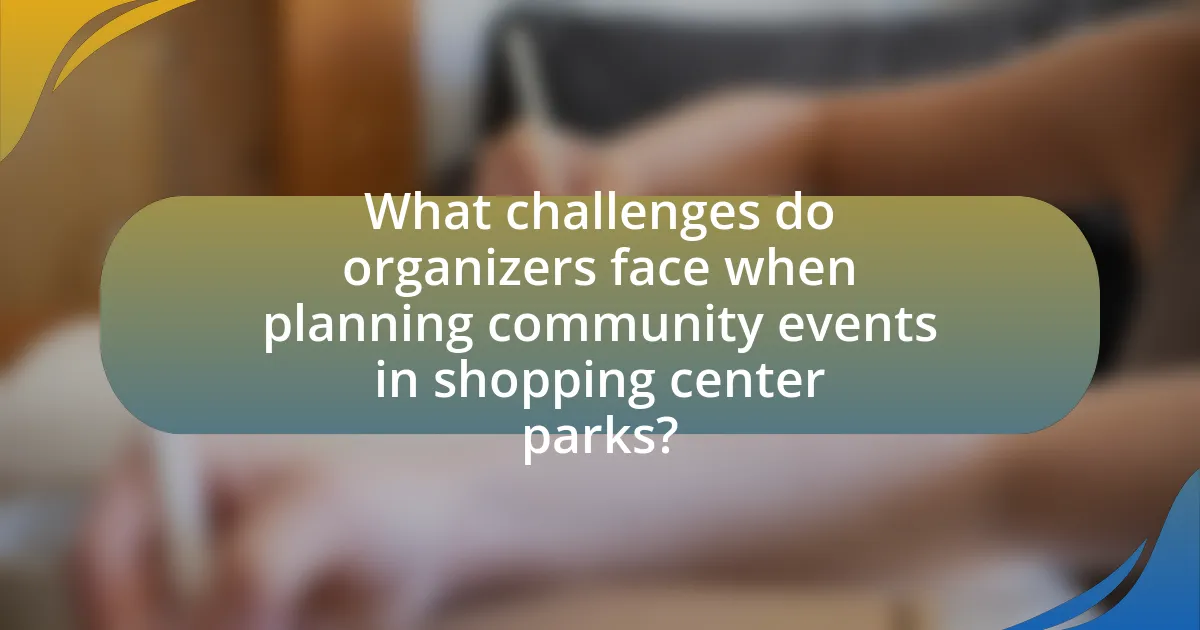
What challenges do organizers face when planning community events in shopping center parks?
Organizers face several challenges when planning community events in shopping center parks, including logistical issues, regulatory compliance, and community engagement. Logistical challenges often involve coordinating space, equipment, and vendor availability, which can be complicated by the park’s layout and existing infrastructure. Regulatory compliance is critical, as organizers must navigate permits, insurance requirements, and safety regulations specific to shopping centers. Additionally, engaging the community can be difficult; organizers need to ensure that events resonate with local interests and demographics, which requires effective marketing and outreach strategies. These challenges are compounded by competition for space and resources from other events and businesses within the shopping center.
How do weather conditions affect event scheduling and attendance?
Weather conditions significantly influence event scheduling and attendance by affecting participants’ willingness to attend and the feasibility of outdoor activities. For instance, adverse weather such as heavy rain or extreme temperatures can lead to cancellations or rescheduling of events, as seen in studies indicating that outdoor events experience a 30% decrease in attendance during inclement weather. Additionally, favorable weather conditions, like mild temperatures and clear skies, can enhance attendance rates, as evidenced by a survey showing that 70% of attendees prefer events held in pleasant weather. Thus, event organizers must consider weather forecasts when planning events to optimize attendance and ensure participant safety.
What contingency plans can be implemented for adverse weather?
Contingency plans for adverse weather include the establishment of alternative indoor venues, the implementation of flexible scheduling, and the provision of real-time weather updates to attendees. Establishing alternative indoor venues ensures that events can continue regardless of outdoor conditions, while flexible scheduling allows for the adjustment of event times or dates based on weather forecasts. Real-time weather updates keep attendees informed, enabling them to make timely decisions about their participation. These strategies are supported by the fact that many community events have successfully adapted to weather challenges, ensuring safety and continued engagement.
How can organizers ensure safety and security during events?
Organizers can ensure safety and security during events by implementing comprehensive risk management strategies. These strategies include conducting thorough risk assessments to identify potential hazards, deploying trained security personnel to monitor the event, and establishing clear emergency response plans. For instance, a study by the International Association of Venue Managers highlights that events with pre-planned security protocols experience 30% fewer incidents compared to those without. Additionally, utilizing technology such as surveillance cameras and crowd management software can enhance safety measures, as evidenced by the increased safety ratings reported by venues that adopted these technologies.
What are the financial considerations for hosting events in shopping center parks?
Hosting events in shopping center parks involves several financial considerations, including venue rental costs, staffing expenses, marketing budgets, and potential revenue generation. Venue rental costs can vary significantly based on location and amenities, with some shopping centers charging fees that can range from a few hundred to several thousand dollars. Staffing expenses include hiring security, event coordinators, and maintenance personnel, which can add to the overall budget. Marketing budgets are essential for promoting the event, and these costs can include digital advertising, print materials, and social media campaigns. Additionally, potential revenue generation from ticket sales, sponsorships, and vendor fees can offset expenses, making it crucial to analyze the financial viability of the event. According to a report by the International Council of Shopping Centers, events can increase foot traffic by up to 30%, highlighting the potential for increased sales for retailers during the event period.
How can sponsorships and partnerships enhance event funding?
Sponsorships and partnerships significantly enhance event funding by providing financial resources and in-kind support that reduce overall costs. These collaborations allow event organizers to access a broader network of potential attendees and increase visibility through the sponsor’s marketing channels. For instance, a study by IEG found that U.S. companies spent over $24 billion on sponsorships in 2020, demonstrating the substantial financial commitment businesses are willing to make to align with community events. This financial backing not only helps cover expenses but also enables organizers to offer more engaging activities, ultimately attracting larger audiences and fostering community engagement.
What budgeting strategies can maximize event profitability?
To maximize event profitability, implement a zero-based budgeting strategy, which requires justifying all expenses from scratch for each event. This approach ensures that every dollar spent is necessary and aligned with the event’s goals, thereby minimizing waste. Research indicates that organizations using zero-based budgeting can reduce costs by 10-20% compared to traditional budgeting methods, as it encourages a thorough review of all expenditures. Additionally, incorporating flexible pricing strategies, such as tiered ticket pricing or early bird discounts, can enhance revenue by attracting a broader audience while optimizing attendance.
What best practices can enhance the success of community events in shopping center parks?
To enhance the success of community events in shopping center parks, effective planning and community engagement are essential. Organizing events that align with local interests and demographics increases participation; for instance, surveys can identify preferred activities. Collaborating with local businesses and organizations can provide resources and sponsorships, fostering a sense of community ownership. Additionally, promoting events through various channels, including social media and local media outlets, ensures wider reach and visibility. According to a study by the International Council of Shopping Centers, events that incorporate interactive elements and cater to families tend to attract larger crowds, demonstrating the importance of engaging programming.
How can effective marketing strategies increase event visibility?
Effective marketing strategies can significantly increase event visibility by utilizing targeted outreach, social media engagement, and strategic partnerships. Targeted outreach ensures that promotional efforts reach the specific demographics most likely to attend the event, thereby maximizing attendance. Social media engagement amplifies event awareness through shares, likes, and comments, creating a viral effect; for instance, events promoted on platforms like Facebook and Instagram can reach thousands of potential attendees quickly. Strategic partnerships with local businesses or influencers can further enhance visibility, as these entities can leverage their own audiences to promote the event. According to a study by Eventbrite, events that utilize social media marketing see a 30% increase in attendance compared to those that do not.
What role does community feedback play in event improvement?
Community feedback is essential for event improvement as it provides direct insights into participant experiences and preferences. By collecting feedback through surveys, social media, and direct communication, event organizers can identify strengths and weaknesses in their offerings. For instance, a study by the Event Marketing Institute found that 70% of event attendees are more likely to return if their feedback is considered in future planning. This data underscores the importance of community input in shaping events that resonate with the audience, ultimately leading to higher satisfaction and increased attendance.


